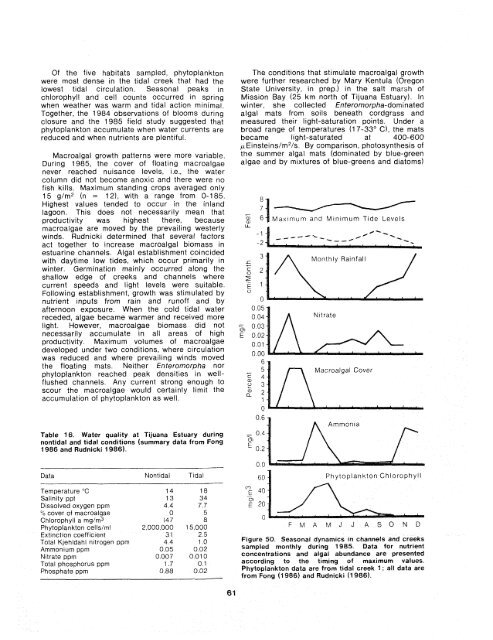The Ecology of Tijuana Estuary, California: An Estuarine Profile
The Ecology of Tijuana Estuary, California: An Estuarine Profile
The Ecology of Tijuana Estuary, California: An Estuarine Profile
You also want an ePaper? Increase the reach of your titles
YUMPU automatically turns print PDFs into web optimized ePapers that Google loves.
Of the five habitats sampled, phytoplankton<br />
were most dense in the tidal creek that had the<br />
lowest tidal circulation. Seasonal peaks in<br />
chlorophyll and cell counts occurred in spring<br />
when weather was warm and tidal action minimal.<br />
Together, the 1984 observations <strong>of</strong> blooms during<br />
closure and the 1985 field study suggested that<br />
phytoplankton accumulate when water currents are<br />
reduced and when nutrients are plentiful.<br />
Macroalgal growth patterns were more variable.<br />
During 1985, the cover <strong>of</strong> floating macroalgae<br />
never reached nuisance levels, i.e., the water<br />
column did not become anoxic and there were no<br />
fish kills. Maximum standing crops averaged only<br />
15 g/m2 (n = 12), with a range from 0-185.<br />
Highest values tended to occur in the inland<br />
lagoon. This does not necessarily mean that<br />
productivity was highest there, because<br />
macroalgae are moved by the prevailing westerly<br />
winds. Rudnicki determined that several factors<br />
act together to increase macroalgal biomass in<br />
estuarine channels. Algal establishment coincided<br />
with daytime low tides, which occur primarily in<br />
winter. Germination mainly occurred along the<br />
shallow edge <strong>of</strong> creeks and channels where<br />
current speeds and light levels were suitable.<br />
Following establishment, growth was stimulated by<br />
nutrient inputs from rain and run<strong>of</strong>f and by<br />
afternoon exposure. When the cold tidal water<br />
receded, algae became warmer and received more<br />
light. However, macroalgae biomass did not<br />
necessarily accumulate in all areas <strong>of</strong> high<br />
productivity. Maximum volumes <strong>of</strong> macroalgae<br />
developed under two conditions, where circulation<br />
was reduced and where prevailing winds moved<br />
the floating mats. Neither Enferomorpha nor<br />
phytoplankton reached peak densities in weliflushed<br />
channels. <strong>An</strong>y current strong enough to<br />
scour the macroalgae would certainly limit the<br />
accumulation <strong>of</strong> phytoplankton as well.<br />
<strong>The</strong> conditions that stimulate macroalgal growth<br />
were further researched by Mary Kentula (Oregon<br />
State University, in prep.) in the salt marsh <strong>of</strong><br />
Mission Bay (25 km north <strong>of</strong> <strong>Tijuana</strong> <strong>Estuary</strong>). In<br />
winter, she collected Enteromorpha-dominated<br />
algal mats from soils beneath cordgrass and<br />
measured their light-saturation points. Under a<br />
broad range <strong>of</strong> temperatures (1 7-33' C), the mats<br />
became light-saturated at 400-600<br />
pEinsteins/m2/s. By comparison, photosynthesis <strong>of</strong><br />
the summer algal mats (dominated by blue-green<br />
algae and by mixtures <strong>of</strong> blue-greens and diatoms)<br />
a,<br />
5<br />
2<br />
r<br />
E<br />
0<br />
-<br />
6{ Max~rnum and Minimum Tide Levels<br />
3 Monthly Rainfall<br />
'<br />
0<br />
5 Macroalgal Cover<br />
= 4<br />
a,<br />
2 3<br />
2 2<br />
1<br />
0<br />
Table 16. Water quality at <strong>Tijuana</strong> <strong>Estuary</strong> during<br />
nontidal and tidal conditions (summary data from Fong<br />
1986 and Rudnicki 1986).<br />
Data Nontidal Tidal<br />
Temperature "C 14<br />
Sal~ntty ppt 13<br />
Dissolved oxygen ppm 4 4<br />
Oo cover <strong>of</strong> macroalgae 0<br />
Chlorophyll a mg/m3 147<br />
Phytoplankton cells/ml 2,000,000<br />
Exfrnctcon coefficient 3 1<br />
Total Kjehldahi nitrogen ppm 4 4<br />
Ammonfurn ppm 0 05<br />
N~trate pprn 0 007<br />
Total phosphorus ppm 17<br />
Phosphate pprn 0 88<br />
60 1 Phytoplankton Chlorophyll<br />
Figure 50. Seasonal dynamics in channels and creeks<br />
sampled monthly during 1985. Data for nutrient<br />
concentrations and algal abundance are presented<br />
according to the timing <strong>of</strong> maximum values.<br />
Phytoplankton data are from tidal creek 1; all data are<br />
from Fong (4 986) and Rudnicki (1 986).

















